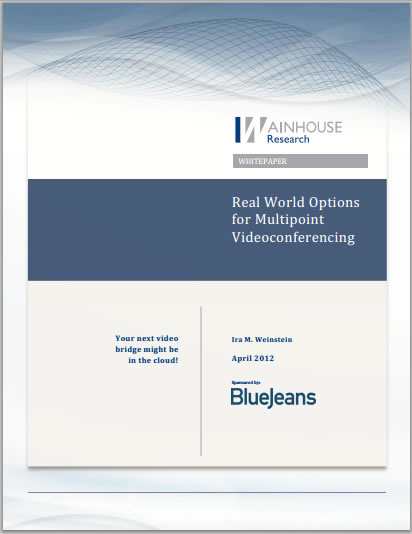
WAINHOUSE RESEARCH WHITE PAPER
Real-world Options for Multipoint Videoconferencing
Explore & compare options to accomplish on-premise multi-point bridging
Explore & compare alternative deployment architectures
Understand the fundamentals involved in multipoint videoconferencing


Download white paper


© 2013 Blue Jeans Network. All rights reserved.
All You Can Meet Offer - Terms & Conditions
- Offer is for companies up to 250 employees. Each employee gets unlimited access to Blue Jeans service
- Offer expires February 20, 2013
- Pricing is for North American customers only. For international pricing please contact your Blue Jeans partner or sales representative
- Customer is required to pay up front for 12 months of unlimited access (“initial term”)
-
Customer has an option to commit at time of purchase to roll forward into a second “right-sized” 12 month commitment (“second term”).
- Customers taking up this offer will be priced for actual usage and will pay as minimum, what they paid for the initial term, but not more than double during the entire second term
- Customers waiving this offer will commit to purchase standard 12 month 3-named hosts plan
Sales: (800) 403-9256

With expansion of video, enterprises are challenged to meet up with increased videoconferencing usage, increased need for multipoint video calling and more importantly increased need for interoperability.
A Multipoint Control Unit (MCU) or at times referred to as video bridge or video bridging service is a device commonly used to bridge videoconferencing connections, usually three (3) or more sessions initiated from terminals, gateways or video endpoints. In this white paper, Wainhouse Research Analyst Ira M. Weinstein evaluates advantages and disadvantages for all MCU deployment models - traditional as well as emerging cloud-based MCU service options.
Download this FREE white paper to understand key trends and how certain approaches are winning over others:
DOWNLOAD WHITE PAPER
– Centralized vs. de-centralized video bridging
– Voice activated switched (VAS) vs. transcoded meetings
– Full screen vs. continuous presence layouts
– Embedded video bridges
– Stand-alone hardware video bridges
– Software video bridge
– Media routing
– Decentralized architecture – a.k.a. multi-stream or mesh network

Evaluate and compare hosted video bridging services
– Providers with third-party video bridges
– Providers with their own platform